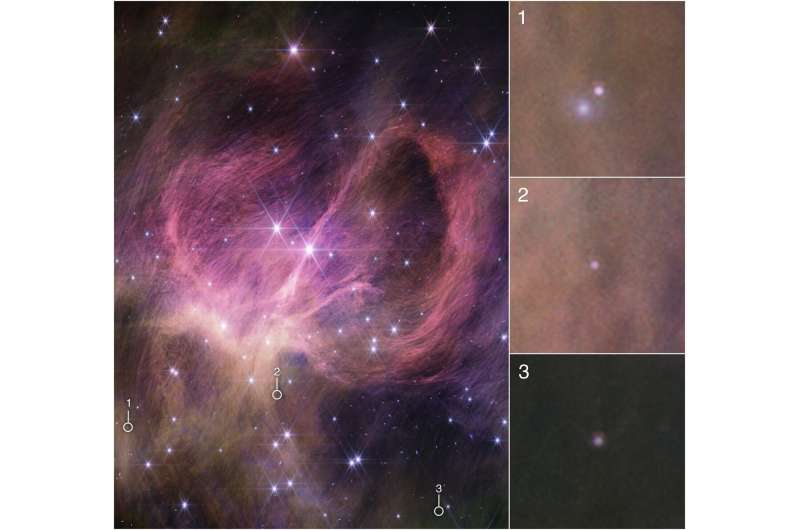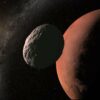Brown dwarfs are sometimes called failed stars, since they form like stars through gravitational collapse, but never gain enough mass to ignite nuclear fusion. The smallest brown dwarfs can overlap in mass with giant planets. In a quest to find the smallest brown dwarf, astronomers using the NASA/ESA/CSA James Webb Space Telescope have found the new record-holder: an object weighing just three to four times the mass of Jupiter.
Brown dwarfs are objects that straddle the dividing line between stars and planets. They form like stars, growing dense enough to collapse under their own gravity, but they never become dense and hot enough to begin fusing hydrogen and turn into a star. At the low end of the scale, some brown dwarfs are comparable with giant planets, weighing just a few times the mass of Jupiter.
Astronomers are trying to determine the smallest object that can form in a star-like manner. An international team using the NASA/ESA/CSA James Webb Space Telescope has identified the new record-holder: a tiny, free-floating brown dwarf with only three to four times the mass of Jupiter.
“One basic question you’ll find in every astronomy textbook is, what are the smallest stars? That’s what we’re trying to answer,” explained lead author Kevin Luhman of Pennsylvania State University.
To locate this newfound brown dwarf, Luhman and his colleague, Catarina Alves de Oliveira, chose to study the star cluster IC 348, located about 1000 light-years away in the Perseus star-forming region. This cluster is young, only about five million years old. As a result, any brown dwarfs would still be relatively bright in infrared light, glowing from the heat of their formation.
The team first imaged the center of the cluster using Webb’s NIRCam (Near-Infrared Camera) to identify brown dwarf candidates from their brightness and colors. They followed up on the most promising targets using Webb’s NIRSpec (Near-Infrared Spectrograph) microshutter array.
Webb’s infrared sensitivity was crucial, allowing the team to detect fainter objects than ground-based telescopes. In addition, Webb’s sharp vision enabled them to determine which red objects were pinpoint brown dwarfs and which were blobby background galaxies.
This winnowing process led to three intriguing targets weighing three to eight Jupiter masses, with surface temperatures ranging from 830 to 1500 degrees Celsius. The smallest of these weighs just three to four times Jupiter, according to computer models.
Explaining how such a small brown dwarf could form is theoretically challenging. A heavy and dense cloud of gas has plenty of gravity to collapse and form a star. However, because of its weaker gravity, it should be more difficult for a small cloud to collapse to form a brown dwarf, and that is especially true for brown dwarfs with the masses of giant planets.
“It’s pretty easy for current models to make giant planets in a disk around a star,” said Catarina Alves de Oliveira of ESA, principal investigator on the observing program. “But in this cluster, it would be unlikely that this object formed in a disk, instead forming like a star, and three Jupiter masses is 300 times smaller than our sun. So we have to ask, how does the star formation process operate at such very, very small masses?”
In addition to providing clues about the star formation process, tiny brown dwarfs also can help astronomers better understand exoplanets. The least massive brown dwarfs overlap with the largest exoplanets; therefore, they would be expected to have some similar properties. However, a free-floating brown dwarf is easier to study than a giant exoplanet since the latter is hidden within the glare of its host star.
Two of the brown dwarfs identified in this survey show the spectral signature of an unidentified hydrocarbon, a molecule containing both hydrogen and carbon atoms. The same infrared signature was detected by NASA’s Cassini mission in the atmospheres of Saturn and its moon Titan. It has also been seen in the interstellar medium, the gas between stars.

Image of a star cluster and nebula, with three image details pulled out in square boxes stacked vertically along the right. Main image is showing wispy pink-purple filaments and a scattering of stars. Each of the three boxes along the right corresponds to a small detail, numbered and circled, in the main image. Box 1 (top): A detail from the lower left of the main image shows a pair of small circular pinkish-white spots on a yellowish-brown background. Box 2 (middle): A detail from the middle of the lower part of the main image shows a single small circular pinkish spot on a yellowish-brown background. Box 3: A detail from the lower right edge of the main image shows a small circular pinkish spot on a dark brown background. © NASA, ESA, CSA, STScI, and K. Luhman (Penn State University) and C. Alves de Oliveira (European Space Agency)
“This is the first time we’ve detected this molecule in the atmosphere of an object outside our solar system,” explained Alves de Oliveira. “Models for brown dwarf atmospheres don’t predict its existence. We’re looking at objects with younger ages and lower masses than we ever have before, and we’re seeing something new and unexpected.”
Since the objects are well within the mass range of giant planets, it raises the question of whether they are indeed brown dwarfs or, in fact, rogue planets that were ejected from planetary systems. While the team can’t rule out the latter, they argue that they are far more likely to be brown dwarfs than ejected planets.
An ejected giant planet is unlikely for two reasons. First, such planets are uncommon in general compared to planets with smaller masses. Second, most stars are low-mass stars, and giant planets are especially rare among those stars. As a result, it’s unlikely that most of the stars in IC 348 (which are low-mass stars) are capable of producing such massive planets. In addition, since the cluster is only five million years old, there probably hasn’t been enough time for giant planets to form and then be ejected from their systems.
The discovery of more such objects will help clarify their status. Theories suggest that rogue planets are more likely to be found in the outskirts of a star cluster, so expanding the search area may identify them if they exist within IC 348.
Future work may also include longer surveys that can detect fainter, smaller objects. The short survey conducted by the team was expected to detect objects as small as twice the mass of Jupiter. Longer surveys could easily reach one Jupiter mass.
These observations were taken as part of Guaranteed Time Observation program #1229. The results were published in The Astronomical Journal.
More information:
K. L. Luhman et al, A JWST Survey for Planetary Mass Brown Dwarfs in IC 348*, The Astronomical Journal (2023). DOI: 10.3847/1538-3881/ad00b7
Citation:
Webb identifies tiniest free-floating brown dwarf (2023, December 13)



